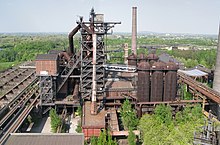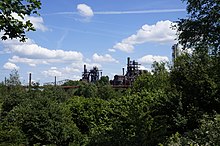Landscape Park Duisburg-Nord



as a spherical panorama




The landscape park Duisburg-Nord (also briefly LaPaDu , popularly known as "Landi") is an approximately 180 hectares large landscaped park around a disused steelworks in Duisburg - Meiderich that as part of the Emscher Park International Building Exhibition originated. The landscape park is one of the anchor points of the European Route of Industrial Culture and the Route of Industrial Culture in the Ruhr Area . The British daily The Guardian counts the Landscape Park North among the ten best city parks in the world. He will u. a. next to High Line (New York) , Buttes-Chaumont (Paris) , Hampstead Heath (London) and Park Güell (Barcelona).
history
The former plant was founded in 1901 by what was then "Rheinische Stahlwerke zu Meiderich bei Ruhrort ", later a subsidiary of the Thyssen Group. The total of five blast furnaces produced 37 million tons of special pig iron in their 84 years - usually as a preliminary product for further processing in Thyssen's steelworks.
The blast furnaces 3 and 4 were in 1968 and 1970 respectively demolished. Blast furnaces 1 and 2 were shut down in 1982, so that only blast furnace 5, which was built in 1973, remained in operation. In 1985, after just twelve years of operation, it was also shut down due to overcapacities on the European steel market. Thyssen relocated steel production to the surrounding, much larger and more modernly equipped main production areas on the Rhine (parts of the Bruckhausen and Schwelgern works, now part of ThyssenKrupp Steel ).
In the period that followed, the old site between Hamborn and Meiderich with all the buildings and the three remaining blast furnaces were advertised as part of the international building exhibition “Emscher Park” and for an international architecture competition that was won by landscape architects Peter Latz + Partner. The Nordpark Duisburg Interest Group has also been supporting the implementation plans since 1988 . From 1990 to 1999, the halls, buildings and the outdoor area were redesigned according to the architects' plans and made so that the park is now one of the most important landscape architecture projects of the turn of the millennium in professional circles . In 1994 the park was opened to the public. It now forms an anchor point on the Route of Industrial Culture and is integrated into the European Route of Industrial Culture.
The Duisburg-Nord landscape park was awarded the Green Good Design Award 2009, EDRA Places Award 2005, Play & Leisure Award 2004, the Grande Medaille d'Urbanisme 2001 and the 1st European Prize for Landscape Architecture Rosa Barba 2000.
Comparable, museum-like, but significantly smaller blast furnace ensembles can be found in Hattingen with the former Henrichshütte , also last a Thyssen AG operation, and in Dortmund-Hörde with the two remaining blast furnaces of Hoesch AG on Phoenix-West .
layout
The basic idea of Latz's design was to work out the genius loci and to create a contrast between it and a new use: Existing buildings should be preserved, used for the park and brought closer to people. The industrial structures, which were interpreted as independent systems, should not be reshaped, but connected visually, functionally or ideally via gardens, terraces, stairs, landmarks or signs. These links include the railway park with the high promenades on the upper level, the water park on the lower level, the isolated vegetation fields between the ribbon structures of the water and railway park and the promenades that connect the city districts. As far as possible, building materials were extracted and reused on site.
Industrial nature
In addition to the ensemble with the remains of the steelworks, an enormously diverse flora and fauna has developed. The artificial, technogenic substrates of the fallow land are mostly poor in nutrients and have a low water storage capacity. Such locations are ideal habitats for warmth-loving animal and plant species. Depending on the development of the area, different vegetation stages can be found in the park, from poor vegetation on raw soil, pioneer vegetation and tall forebear communities through bush stages to pre-forest (industrial forest). Such flora and fauna, which developed on former industrial and commercial areas, is called industrial nature in the Ruhr area. In the landscape park, it has developed in an outstanding manner thanks to a precisely aligned maintenance management. Quality assurance takes place by means of monitoring by the Biological Station Western Ruhr Area in cooperation with the park administration.
Development of the park
Since the ironworks was first presented to the public in 1994, visitors, hikers, cyclists, sports clubs, organizers and interest groups have used the park for their own purposes. Duisburg Marketing GmbH, a holding company of the City of Duisburg, still controls the further development of the Landscape Park Duisburg-Nord project to this day.
- In the gasometer filled with 20,000 cubic meters of water , which was in operation at Bochum's Prinz Regent colliery until 1920, divers developed a training center that is used by amateur divers as well as the police and fire brigade due to its diverse underwater landscape .
- The German Alpine Association built an alpine climbing garden in part of the ore bunker complex with around 400 routes from difficulty levels II to IX and a via ferrata with levels of difficulty A to E.
- There is an altitude climbing course in the casting hall of blast furnace 2 .
- In 2005, the Biological Station Western Ruhr Area opened a branch in the building of the former sampling point. Tasks in the park are the scientific supervision of the park maintenance, in particular the maintenance of industrial nature in cooperation with the park administration, as well as the implementation of environmental education events for schools. Plus a special offer of excursions in the park to flora and fauna for experts.
- The former blast furnace 5 was made accessible up to the second highest point. The crane standing over there is no longer accessible. At a height of approx. 70 m you have a very good view over the city of Duisburg and into the neighboring cities. In good weather, the Düsseldorf TV tower can be seen.
- The former power station, the casting hall and the blower hall complex were renovated as part of the development of the landscape park and converted into multifunctional event locations. The casting hall - the tapping hall of blast furnace 1 - received a grandstand and a roof, and open-air cinema takes place here in summer . The steam blower house was converted into a theater with 500 seats. In August 2010, the reconstruction of the world premiere of Gustav Mahler's 8th Symphony (Symphony of a Thousand) with over a thousand choir singers and musicians from many Ruhr area orchestras took place in the former power center . The English dancer Akram Khan also staged the German premiere of the group choreography Vertical Road .
- The industrial plants are set in scene every day at nightfall (via a twilight sensor) until 01:00 a.m. by means of colored lighting by Jonathan Park .
- There are guided tours for children and adults by day and night. Registration at the visitor center is required for this. Groups can choose from around ten different tours and games. A bicycle rental service is attached to the visitor center; further bike stations can be found along the route of industrial culture. The visitor center also offers more information on the route of industrial culture as well as books, postcards and souvenirs on the subject of the Ruhr area.
- A permanent exhibition on the history of the iron and steel works was set up on the first floor of the warehouse building.
- Another landmark of the landscape park - besides the three chimneys - is the wind turbine , which can also be seen from a great distance. It is connected to a water pump via a gearbox and uses a screw to convey the water from the Old Emscher for the bunker gardens. The oxygen enrichment also improves the biological quality of the watercourse.
- During the annual ExtraSchicht , the landscape park is one of the central venues.
- With 1,019,391 visitors and over 800 rentals of the individual event areas and halls, 2016 was the most successful year since the opening in 1994.
- The Stadtwerke Duisburg's Stadtwerke Summer Cinema takes place here every year.
- The HistoriCar classic car event took place annually between 2005 and 2015 in the Landscape Park. The event has been running under the name Motorworld HistoriCar since 2018.
- The 3rd Ruhr Games took place on the grounds of the landscape park between June 20 and 23, 2019 .
literature
- Peter Latz: ROST ROT - The Duisburg-Nord Landscape Park. Munich 2016, ISBN 978-3-7774-2426-2
- Technical University of Munich, Chair for Landscape Architecture and Industrial Landscape LAI (Ed.): Learning from Duisburg Nord. Munich 2009, ISBN 978-3-941370-07-4
- Corinne book, Peter Keil: industrial nature. Working materials for teaching and environmental education on industrial sites in the Ruhr area , published by Biological Station Westliches Ruhrgebiet, Oberhausen 2013, ISBN 978-3-00-041434-3
- Wilfried Hoppe, Stefan Kronsbein: Landscape Park Duisburg-Nord , Mercator-Verlag, Duisburg 1999, ISBN 3-87463-280-6
- Peter Latz: About the idea of making time visible - The idea of making time visible . In: Topos 33, 12/2000
- Angela Schwarz (editor): From industrial company to landscape park . Klartext-Verlag, 2001, ISBN 3-88474-967-6
- Udo Weilacher: Climber on Monte Tyssino. Landscape Park Duisburg-Nord . In: Udo Weilacher: In gardens. Profiles of current European landscape architecture. Basel Berlin Boston 2005, pp. 70 ff., ISBN 3-7643-7084-X
- Udo Weilacher: Syntax of the Landscape. The landscape architecture by Peter Latz and Partners. Basel Berlin Boston 2007, ISBN 978-3-7643-7614-7
- Udo Weilacher: Learning from Duisburg-Nord in: Topos. The international review of landscape architecture and urban design. 69/2009. Trap. Callwey Verlag Munich. Pp. 94-97
- Christoph Wilmer: Landschaftspark Duisburg-Nord , Himmerod 7 Verlag, Himmerod 2016, ISBN 978-3-9814117-4-4
- Ralf Winkels & Günter Zieling: Landschaftspark Duisburg-Nord - From iron cooking pot to adventure park. Duisburg 2009. ISBN 978-3-87463-447-2
- Zeitzeugenbörse Duisburg eV: Duisburger Hüttenwerke , Erfurt 2014, ISBN 978-3-95400-364-8
Web links
- Description of this attraction and anchor point as part of the Route of Industrial Heritage
- Landscape park website
- The gasometer
- The DAV section Duisburg with its climbing garden
- Industriedenkmal.de with photo gallery and history of the iron and steel works in Meiderich
- Night shots of the landscape park with light installations by Jonathan Park
- Website of the Biological Station Western Ruhr Area eV
- Picture gallery with night photos from the Landscape Park Duisburg North 2014
- 360 ° panorama of the Landscape Park North at night
Individual evidence
- ↑ Rowan Moore, The Guardian , Green space.The 10 best parks , Aug. 7, 2015; accessed on April 15, 2017
- ↑ a b Duisburg-Nord Landscape Park . 1998 in the online exhibition 100 years of landscape architecture by the bdla . Retrieved May 4, 2014.
- ↑ RVR leaflet on industrial nature on the site (PDF; 2.0 MB). (PDF) Retrieved January 10, 2016 .
- ↑ Rheinische Industriekultur e. V .: Walter Buschmann: AG Hüttenbetriebe Meiderich
- ^ FAZ of September 14, 2010, page 35
- ^ FAZ of October 8, 2010, page 34
- ↑ As if it were a piece of space in FAZ of September 5, 2013, page R4
- ↑ RP-Online: Landscape Park more successful than ever. Retrieved January 6, 2017 .
- ↑ Ruhr Games 2019: The festival that brings young people to the stage. June 18, 2019, accessed June 19, 2019 .
- ^ Ruhr Games. June 27, 2019, accessed June 27, 2019 .
Coordinates: 51 ° 28 ′ 49 ″ N , 6 ° 46 ′ 48 ″ E














